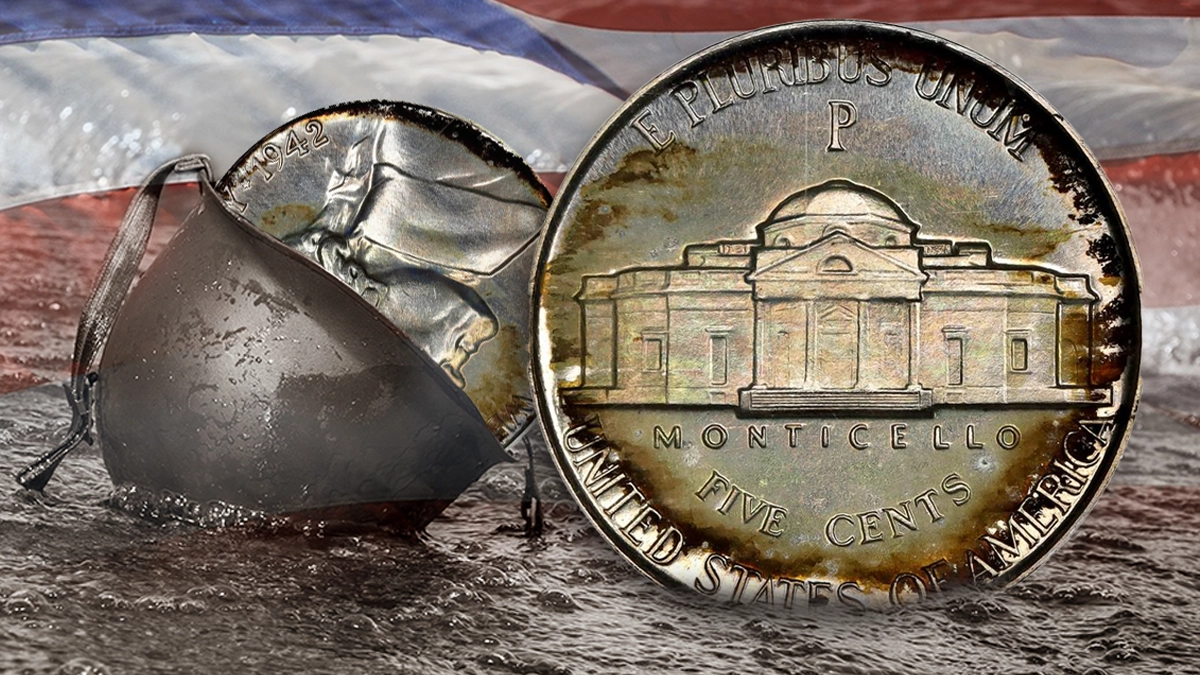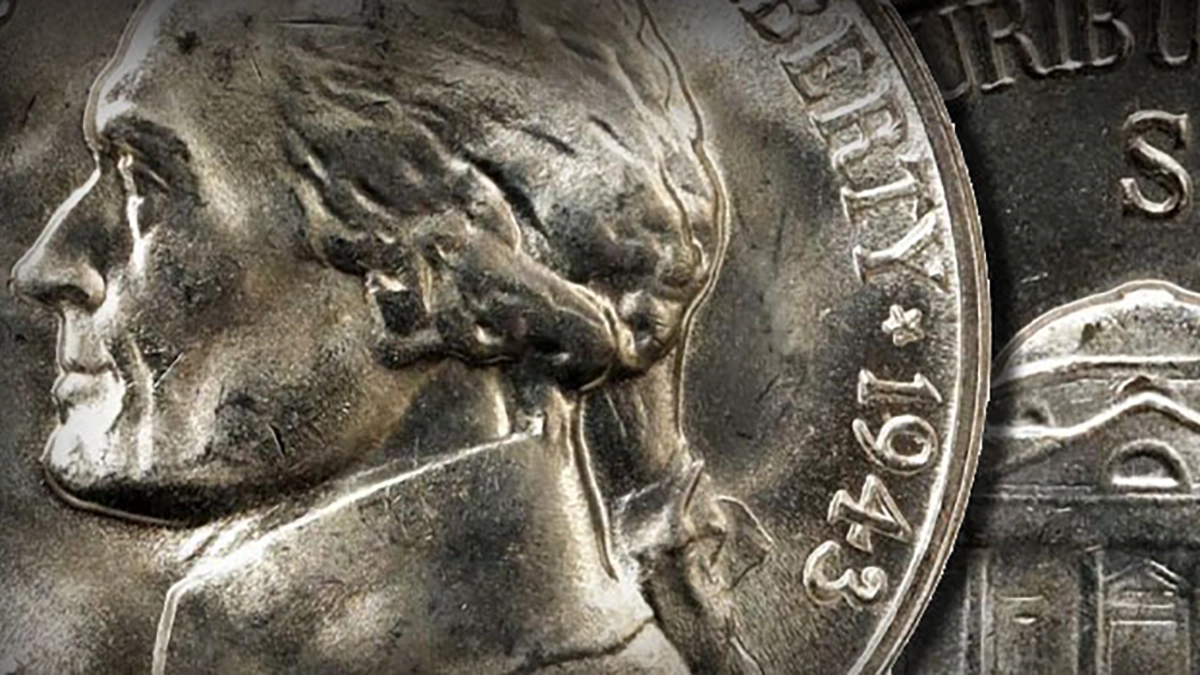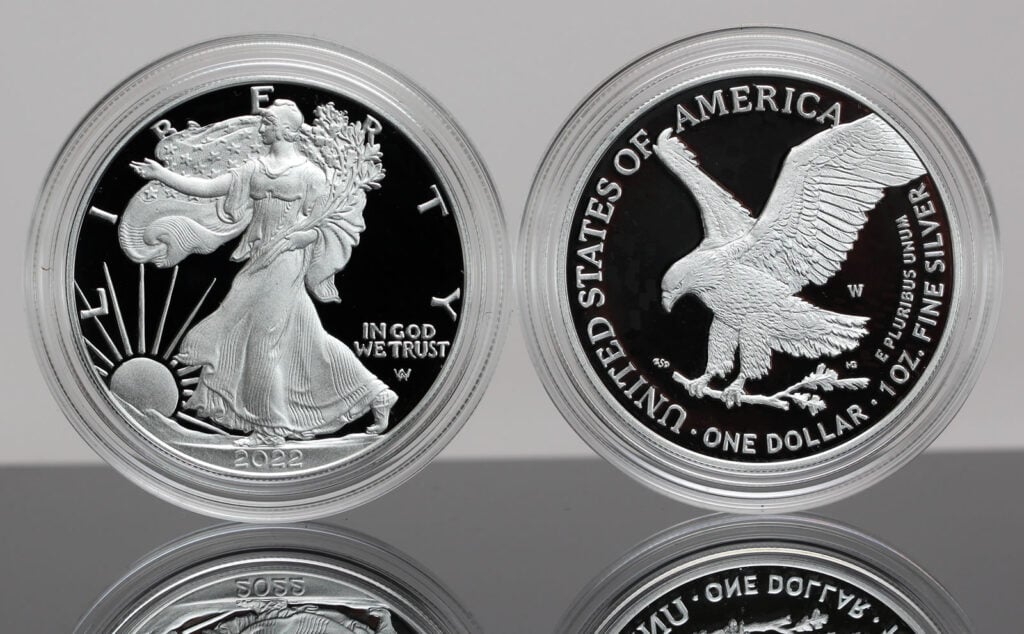
By Charles Morgan and Hubert Walker for CoinWeek Notes ….
As the United States converted its industrial might to the war effort, the Federal Government looked closely at its supply of strategic materials. Copper, used to produce cents and alloyed with silver and gold to produce other denominations, was diverted for military use in 1943. Nickel, used to strike the Jefferson Nickel five-cent coin, was diverted for military use in the spring of 1942 and continued to be missing from coinage until the war’s conclusion in 1945. It was used in the construction of P-51 Mustang and the B-29 Superfortress. Additionally, nickel’s anti-corrosive properties made it ideal for the construction of navy ships and amphibious landing craft.
The Search for a Replacement Metal
The United States Mint’s search for a replacement for nickel raised an issue that had previously came up during the transition from the Liberty Head Nickel to the Indian Head or Buffalo Nickel: the replacement metal would have to satisfy the needs of the vending machine industry.
Vending machines not only check a coin’s weight but also its electrical resistance. Any substitute for nickel in the five-cent coin would need to meet both requirements. Otherwise, tens of thousands of pieces of equipment installed around the country would not recognize the new coins.
Following several trials, metallurgists discovered that an alloy of copper, silver, and manganese met the weight and electrical specifications. With the passage of the Act of March 27, 1942, Congress authorized the War Nickel alloy.
The first coins of the new tenor were produced in October of that year. Thus, five-cent coins were minted without their namesake constituent – there was no nickel in the “nickel”. Wartime nickels marked the first time that silver had been used in a five-cent denomination since the half dime was last minted in 1873.
How Can I Tell if I Have a War Nickel?
Not every nickel struck in 1942 is a War Nickel.
Before the March 27 authorization, the mints at Philadelphia and Denver struck a combined 63,727,000 coins. After the new silver alloy was authorized, the Philadelphia Mint struck 57,873,000 nickels for circulation and 27,600 examples in Proof. The Denver Mint did not produce additional nickels in 1942, but the San Francisco Mint turned out 32,900,000 War Nickels after producing none in the usual composition.
The Mint needed to differentiate nickels struck in the wartime alloy from normal nickels, so it used oversized mintmarks.
Typically, the mintmarks for Denver and San Francisco strikes appear as small letters positioned just above the steps on the far right of Monticello, President and Founding Father Thomas Jefferson’s mansion, on the reverse. Nickels struck in the silver alloy have an oversized mintmark placed above the dome of Monticello. To comply with this requirement, for the first time, the “P” mintmark was used to signify coins minted at Philadelphia.
After the war, the coinage in the standard nickel composition resumed, and the small mintmark returned to its normal position for “D” and “S” mint coins. The removal of 870 million Jefferson War Nickels took place over time. Primarily, the general public removed the coins, as is often the case when “bad” money follows “good”. Interest in collecting nickels in the unusual wartime composition grew after the war, and today, collector sets comprised of worn examples are often packaged and marketed to beginner collectors.
Characteristics of the Jefferson War Nickel
Nickels produced in the wartime composition have a different appearance than the typical Jefferson Nickel. The coins are brighter and typically better struck. These coins also tone like 90% silver coins and are sometimes encountered with vivid iridescent toning. Full Steps details are also frequently encountered on nickels of this period.
Not every coin was made well, however. The wartime alloy did not always blend well, and lamination defects and irregular oxidation effects are not uncommon. It’s best to avoid coins with these impairments if building a high-end registry set.
Jefferson War Nickel Varieties
Several collectible varieties are known, including 1943-P, 3 Over 2; 1943-P, Doubled-Die Obverse; 1943-P, Doubled Eye; 1945-P, Doubled-Die Reverse; and other minor die variations.
In addition, off-metal strikes were produced. Some 1942-P and 1943-P nickels were produced on copper-nickel blanks, while some 1946 examples were minted on silver composition blanks – a situation not unlike that of the 1943 Bronze Cent.
Henning’s Folly

In the early 1950s, 1944 copper-nickel coins without the P mintmark were discovered in circulation, but these were determined to be counterfeits. CoinWeek contributing writer Tyler Rossi wrote an excellent piece on the Henning counterfeit 1944 nickels.
In-Depth Jefferson War Nickel Date Analysis by CoinWeek Notes

Design
Obverse:
The obverse displays a left-facing portrait of President and Founding Father Thomas Jefferson, who wears a coat and a wig representative of the period. Inside a flat rim is the motto IN GOD WE TRUST to the left of the portrait, and the word LIBERTY and the date to the right, the last two separated by a small centered five-point star.
Reverse:
The reverse shows an elevation view of the front of Jefferson’s Virginia mansion Monticello, with the word MONTICELLO below. Around the smooth rim are the motto E PLURIBUS UNUM at the top and the legend UNITED STATES OF AMERICA at the bottom; The denomination FIVE CENTS in smaller letters forms a concentric arc above STATES OF and below MONTICELLO. Wartime nickels were minted in Philadelphia, San Francisco, and Denver; P, S, and D mintmarks are located above the building, below E PLURIBUS UNUM.
Edge:
The edge of all Jefferson War Nickels is plain or smooth, without reeding or edge lettering.
Designer
Felix Schlag was born in Frankfurt, Germany in 1891. After receiving an education at the Munich University of Fine Arts, he moved to the United States in 1929. Schlag died in 1974. Yet while he did win numerous art contests and commissions throughout much of the remainder of his life, the Jefferson Nickel was his only coin design.
Coin Specifications
| Jefferson War Nickel | |
| Years of Issue: | 1942-45 |
| Mintage (Circulation): | High: 271,165,000 (1943-P); Low: 15,294,000 (1943-D) |
| Mintage (Proof): | 27,600 (1942-P only) |
| Alloy: | .560 copper, .350 silver, and .090 manganese |
| Weight: | 5.00 g |
| Diameter: | 21.20 mm |
| Edge: | Plain |
| OBV Designer: | Felix Schlag |
| REV Designer: | Felix Schlag |
* * *
Additional References
Bowers, Q. David. The Experts Guide to Collecting and Investing in Rare Coins. Whitman Publishing.
–. A Guide Book of Buffalo and Jefferson Nickels. Whitman Publishing.
–. A Guide Book of United States Type Coins. Whitman Publishing.
Breen, Walter. Walter Breen’s Encyclopedia of U.S. Coins. Doubleday.
Guth, Ron, and Jeff Garrett. United States Coinage: A Study by Type. Whitman Publishing.
Taxay, Don. The U.S. Mint and Coinage. Arco Publishing.
Yeoman, R.S., and Jeff Garrett (editor). The Official Red Book: A Guide Book of United States Coins. Whitman Publishing.
* * *
The post Jefferson War Nickel, 1942-1945 : A Collector’s Guide appeared first on CoinWeek: Rare Coin, Currency, and Bullion News for Collectors.



